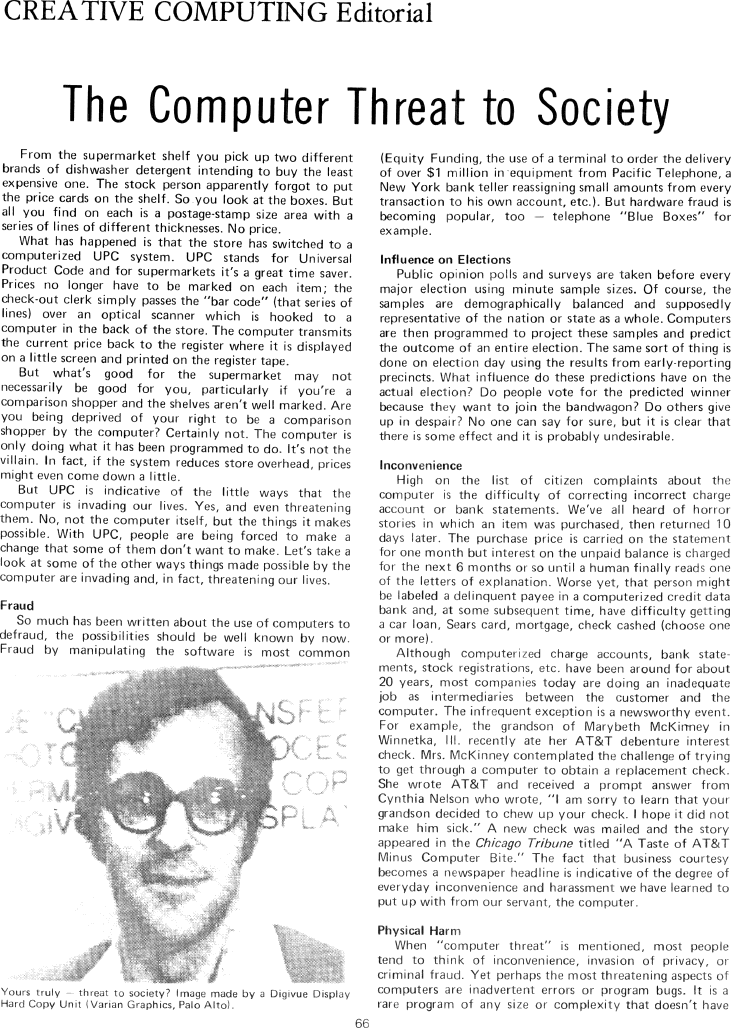The Best of Creative Computing Volume 1 (published 1976)
The Computer Threat to Society (Fraud, influence on elections, physical harm)

CREATIVE COMPUTING Editorial
The Computer Threat to Society
From the supermarket shelf you pick up two different
brands of dishwasher detergent intending to buy the least
expensive one. The stock person apparently forgot to put
the price cards on the shelf. So.you look at the boxes. But
all you find on each is a postage-stamp size area with a
series of lines of different thicknesses. No price.
What has happened is that the store has switched to a
computerized UPC system. UPC stands for Universal
Product Code and for supermarkets it's a great time saver.
Prices no longer have to be marked on each item; the
check-out clerk simply passes the ”bar code" (that series of
lines) over an optical scanner which is hooked to a
computer in the back of the store. The computer transmits
the current price back to the register where it is displayed
on a little screen and printed on the register tape.
But what's good for the supermarket may not
necessarily be good for you, particularly if you're a
comparison shopper and the shelves aren't well marked. Are
you being deprived of your right to be a comparison
shopper by the computer? Certainly not. The computer is
only doing what it has been programmed to do. lt's not the
villain. In fact, if the system reduces store overhead, prices
might even come down a little.
But UPC is indicative of the little ways that the
computer is invading our lives. Yes, and even threatening
them. No, not the computer itself, but the things it makes
possible. With UPC, people are being forced to make a
change that some of them don't want to make. Let's take a
look at some of the other ways things made possible by the
computer are invading and, in fact, threatening our lives.
Fraud
So much has been written about the use of computers to
defraud, the possibilities should be well known by now.
Fraud by manipulating the software is most common
Yours truly - threat to society? Image made by a Digivue Display
Hard Copy Unit (Varian Graphics, Palo Alto).
(Equity Funding, the use of a terminal to order the delivery
of over $1 million in'equipment from Pacific Telephone, a
New York bank teller reassigning small amounts from every
transaction to his own account, etc.). But hardware fraud is
becoming popular, too - telephone "Blue Boxes" for
example.
Influence on Elections
Public opinion polls and surveys are taken before every
major election using minute sample sizes. Of course, the
samples are demographically balanced and supposedly
representative of the nation or state as a whole. Computers
are then programmed to project these samples and predict
the outcome of an entire election. The same sort of thing is
done on election day using the results from early-reporting
precincts. What influence do these predictions have on the
actual election? Do people vote for the predicted winner
because they want to join the bandwagon? Do others give
up in despair? No one can say for sure, but it is clear that
there is some effect and it is probably undesirable.
lnconvenience
High on the list of citizen complaints about the
computer is the difficulty of correcting incorrect charge
account or bank statements. We've all heard of horror
stories in which an item was purchased, then returned 10
days later. The purchase price is carried on the statement
for one month but interest on the unpaid balance is charged
for the next 6 months or so until a human finally reads one
of the letters of explanation. Worse yet, that person might
be labeled a delinquent payee in a computerized credit data
bank and, at some subsequent time, have difficulty getting
a car loan, Sears card, mortgage, check cashed (choose one
or more).
Although computerized charge accounts, bank state
ments, stock registrations,etc.have been around for about
20 years, most companies today are doing an inadequate
job as intermediaries between the customer and the
computer. The infrequent exception is a newsworthy event.
For example, the grandson of Marybeth McKinney in
Winnetka, Ill. recently ate her AT&T debenture interest
check. Mrs.McKinney contemplated the challenge of trying
to get through a computer to obtain a replacement check.
She wrote AT&T and received a prompt answer from
Cynthia Nelson who wrote, "l am sorry to learn that your
grandson decided to chew up your check. l hope it did not
make him sick." A new check was mailed and the story
appeared in the Chicago Tribune titled "A Taste of AT&T
Minus Computer Bite." The fact that business courtesy
becomes a newspaper headline is indicative of the degree of
everyday inconvenience and harassment we have learned to
put up with from our servant, the computer.
Physical Harm
When "computer threat" is mentioned, most people
tend to think of inconvenience, invasion of privacy, or
criminal fraud. Yet perhaps the most threatening aspects of
computers are inadvertent errors or program bugs. It is a
rare program of any size or complexity that doesn't have


